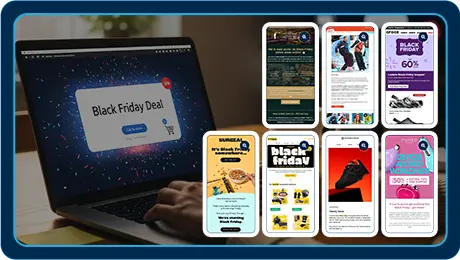
Image Source – Business2Community
After all, marketing automation saves time. Integrates seamlessly. And moves prospects through the lead funnel with the use of otherwise complicated data. And with those fiddly, time-consuming, manual tasks being taken care of. Marketing automation also enables businesses to scale and grow faster. Improve the sophistication of their marketing activity. And increase productivity. Win-win. So, if you have high hopes of acquiring more customers through marketing automation. Or simply want to improve your current marketing automation activity. Read on to learn our 5 best practices for marketing automation and acquisition.Simple triggered emails
Once a potential customer engages with your brand, whether that be through signing up to your email list, putting an item in their basket, or making an enquiry, you want to get in touch with them. Immediately. The more time there is between them engaging and you making contact. The less chance of you acquiring them as a customer. This is where simple, triggered emails come to the rescue. They eliminate the need for marketers to manually contact each individual. Instead, an automation trigger ensures that a communication is immediately sent to the potential customer. Keeping them engaged and warm. And if that isn’t enough. They have a consistent open rate of 45% – 55%. Four times higher than newsletters. The options for triggered emails are vast. Some of the most popular include welcome emails, order confirmations, and abandoned basket reminders.
Yes, they are simple. But they offer reassurance to the potential customer that their action has been acknowledged. And shows that you care about their custom.
The options for triggered emails are vast. Some of the most popular include welcome emails, order confirmations, and abandoned basket reminders.
Yes, they are simple. But they offer reassurance to the potential customer that their action has been acknowledged. And shows that you care about their custom.

Targeted email communications
Simple triggered emails are clearly great. But offering highly personalised, targeted email communications is a real step up. And these communications are increasingly essential to cut through the noise of other brands. Targeted communications can be based on a host of variants. Demographics such as age or location. Browsing behaviour. Even lifecycle stage. You could send a birthday email with a freebie. Recommend content or products based on browsing behaviour. Or offer a discount code to the people who have been engaging the most.
Dynamic landing pages
Marketing automation gives brands the power to personalise any touch-point on their website with any type of content. Offering complete flexibility to optimise the entire path to purchase. Dynamic landing pages use marketing automation to display different messages to different website visitors. Dependent on key variables. Similar to targeted emails, this could include demographics, browsing history, and lifecycle stage. So, instead of arriving on a generic landing page, based on a single campaign, goal, or set of keywords. The landing page will be tailored to the visitor’s individual requirements. And by message, we’re not just referring to the copy. Yes, a good place to start is with dynamic titles and headers. But this can be advanced to product recommendations. Calls to action. Recommended content. Even real-time, location-specific weather forecasts.
Multi-channel campaigns
The most effective marketing activities will involve email, social media, paid advertising, SMS, and dynamic website experiences. However, this can become complicated. Quickly. And that’s before you consider the need for a streamlined narrative, brand guidelines, and a journey for each audience segment. In the past, marketers were restricted to manually creating, testing, and executing their campaigns. Meaning they had to make do with simple, channel-specific automations with little to no personalisation or relevance to the recipient or viewer. Fortunately, with the help of powerful marketing automation tools and platforms, marketers are able to execute sophisticated, multi-channel nurturing techniques. They can engage with potential customers on the best channels. At the best time. Consider sending out triggered messages via email and SMS. Personalising your landing pages to match your paid ads. Or pulling through social media posts as recommended content on your website.


